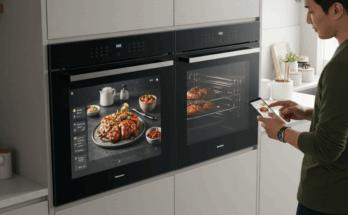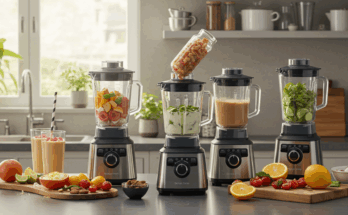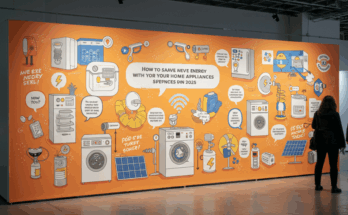Have you ever glanced at your electricity bill and felt your stomach drop? You’re not alone. Last month, my friend Sarah texted me angrily: “How is my bill $200 again? I barely even turn the lights on!” I laughed, but I got it. Between heating, cooling, and keeping the fridge humming, energy costs can sneak up on you like a ninja. But here’s the good news: energy-saving appliances can slash those bills—sometimes by half—without forcing you to live like a caveman. Let’s dive into the world of appliances that don’t just save energy but save your wallet, too.
Why Energy-Saving Appliances Matter
Picture this: You’re sipping coffee on a chilly morning, the heater’s buzzing, and the dishwasher’s mid-cycle. Sounds cozy, right? But all that comfort comes with a price. According to the U.S. Department of Energy, the average household spends about $ 2,000 annually on energy. That’s a big chunk of change! Appliances like refrigerators, washers, and water heaters are often the culprits, guzzling power like it’s going out of style.
Energy-efficient appliances flip the script. They use cutting-edge tech to do the same job with less juice. Think of them as the superheroes of your home—saving the day (and your bank account) one watt at a time. Ready to meet the lineup? Let’s go.
Top Energy-Saving Appliances to Slash Your Bills
1. Energy-Efficient Refrigerators: Cool Savings Await
Your fridge is like the unsung hero of the kitchen, running 24/7 to keep your leftovers fresh. But older models? They’re energy hogs. A study from Energy Star says a modern, efficient fridge uses about 35% less energy than one from the early 2000s. That’s hundreds of dollars saved over its lifetime.
Take my neighbor, Mike. He swapped his clunky 15-year-old fridge for an Energy Star-certified model last year. “My bill dropped by $30 a month,” he told me over a barbecue. “And it’s got more space!” Look for features like inverter compressors or better insulation—they’re game-changers.
Pro Tip: Aim for a fridge with the Energy Star label. It’s your ticket to lower bills and a happier planet.
2. Smart Thermostats: Heat Smarter, Not Harder
Raise your hand if you’ve ever accidentally left the heat on all day. Guilty! A smart thermostat can stop that nonsense. These little gadgets learn your routine and adjust temperatures automatically. The Nest Learning Thermostat, for example, claims to save users 10-12% on heating and 15% on cooling annually.
I installed one last winter after my cousin raved about hers. In the first month, I saved $25—and that was during a brutal cold snap. It’s like having a tiny energy coach whispering, “Hey, let’s not overdo it.”
Snippet Alert: Want to cut heating costs? A smart thermostat can save up to 15% on cooling bills alone.
3. Tankless Water Heaters: Hot Water, Low Costs
Traditional water heaters are like that friend who overstays their welcome—they keep water hot even when you don’t need it. Tankless water heaters? They heat water on demand, slashing energy use by up to 34%, per the Department of Energy.
My sister, Jen, got one after her old tank died. “I was skeptical,” she admitted, “but my gas bill’s down 40%.” She never runs out of hot water during her famously long showers. Installation’s pricier upfront, but what about the payoff? Worth it.
4. Front-Load Washing Machines: Clean Clothes, Cleaner Savings
Top-load washers might feel nostalgic, but they’re water and energy gluttons. Front-loaders, especially high-efficiency (HE) models, use 20-50% less energy and water. A report from the American Council for an Energy-Efficient Economy backs this up, noting savings of $100+ per year.
I made the switch two years ago. Not only did my bill shrink, but my clothes came out cleaner. Bonus: They’re gentler on fabrics, so my favorite hoodie’s still kicking.
5. LED Lighting: Bright Ideas for Less
Okay, LEDs aren’t appliances, but they’re bill-slashing MVPs. They use 75% less energy than old-school incandescent bulbs and last 25 times longer, according to Energy.gov. Swapping out just five bulbs could save you $75 a year.
My buddy Tom did a full-house LED overhaul. “It’s like I’m living in the future,” he joked. His electric bill? Down by a cool $50 monthly. Dimmer switches and smart bulbs can boost those savings even more.
How Much Can You Save?
Let’s crunch some numbers. Say you upgrade your fridge ($30/month savings), add a smart thermostat ($25/month), and switch to a tankless heater ($40/month). That’s $95 monthly—over $1,100 a year! Factor in a new washer and LEDs, and you’re flirting with cutting your energy bill in half. A $200 monthly bill like Sarah’s is $100 back in her pocket.
Sure, the upfront cost can sting. However, many utilities offer rebates, and the long-term savings are hard to ignore. Dr. Emily Carter, an energy efficiency expert at MIT, puts it bluntly: “Investing in efficient appliances is like giving yourself a raise.”
Real-Life Wins: Stories That Inspire
Need more proof? Meet Lisa, a single mom from Ohio. She swapped her ancient fridge and water heater for energy-efficient models after a brutal $250 winter bill. Six months later, she’s averaging $120 monthly. “It’s a game-changer,” she told me over Zoom. “I can finally save for my kid’s college.”
Then there’s Carlos, a renter in Texas. He couldn’t replace big appliances, so he focused on LEDs and a smart thermostat. His $150 bill dropped to $90. “Small changes, big difference,” he grinned.
Tips to Maximize Your Savings
-
- Maintenance Matters: Clean fridge coils and washer filters. A little TLC keeps efficiency high.
-
- Timing Is Everything: Run appliances during off-peak hours if your utility offers lower rates.
-
- Layer Up: Combine upgrades with habits like shorter showers or air-drying clothes.
-
- Check Rebates: Look up local energy programs—free money is out there!
Why It’s Worth the Switch
Beyond the dollars, there’s a feel-good factor. Energy-efficient appliances cut your carbon footprint, helping the planet breathe easier. Plus, who doesn’t love outsmarting skyrocketing utility costs? It’s practical, it’s bright, and it’s doable.
So, next time your bill arrives, don’t just grow—take action. Start small with LED, or go big with a tankless heater. Your wallet (and maybe Sarah’ shh) will thank you.
Your Energy-Saving Questions Answered
How do energy-efficient appliances save money?
They use less electricity or gas to do the same job, lowering your utility bills over time.
Are energy-saving appliances worth the cost?
Yes! The initial price is higher, but savings—often 30-50% on energy costs—pay off within a few years.
What’s the best first upgrade?
A smart thermostat or LED lights. They’re affordable, easy to install, and deliver instant savings.
Can renters use energy-saving appliances?
Absolutely. Focus on portable options like LEDs and smart plugs or even negotiate with landlords for bigger upgrades.
How do I know if an appliance is energy-efficient?
Look for the Energy Star label or check its energy consumption rating (kWh) on the spec sheet.




